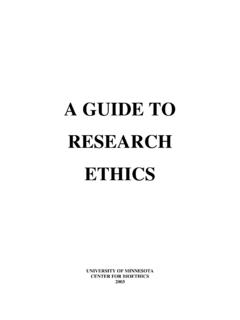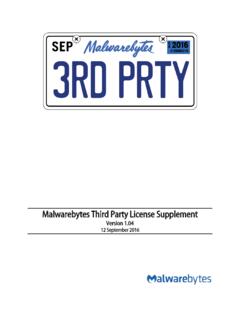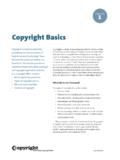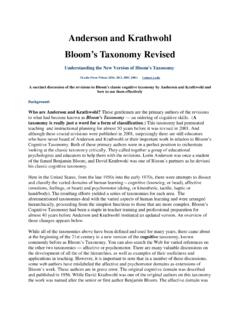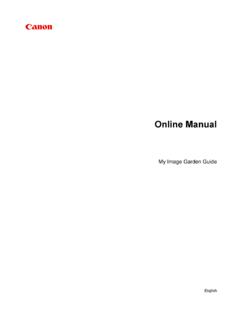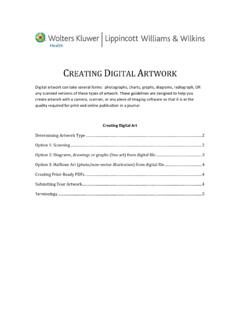Transcription of Determining Inventorship for US Patent Applications
1 US Patent law provides that whoever invents patentable subject matter is entitled to a , US Patent Applications must list the true andonly this rule seems clear, the Courtof Appeals for the Federal Circuit has addressed the ques-tion of proper Inventorship at least a dozen times withinthe past three years and has reversed or vacated nearlyone-half of the decisions from the district courts on , there is an important but often underem-phasized role in correctly Determining who should belisted as an inventor for a Are the True and Only Inventors?In the United States, invention is a two-step process:1. Conception of the idea or subject matter of the patentclaims, which may be comprised of several claims; and2. Reduction of the idea to practice, or making a work-ing example of the claimed of proper Inventorship focuses almostexclusively on the conception step,4requiring the iden-tification of each person who conceived the idea orideas of the Patent Patent law, conception is normally defined as theformation in the mind of the inventor, of a definite andpermanent idea of the complete and operative inven-tion, as it is thereafter to be applied in practice.
2 5 Thephrase definite and permanent means that only ordi-nary skill would be necessary to reduce the invention topractice, or make a working example of the invention,without extensive research or , conception is complete when an idea is suf-ficiently definite and permanent to permit one with ordinary skill in the field to reduce it to practice without undue must becomplete and must include every feature of the subjectmatter claimed in the an Inventorship determination focuses onthe invention claimed and not merely describedin apatent, the first step in an Inventorship analysis is to de-termine the scope and meaning of the exact subject matter of the Patent claims has beendetermined, the appropriate individuals can be verifiedwho conceived each of the claims that represent the following points should help in an inventor is: A person who conceives the subject matter of at leastone claim of the Patent .
3 Two or more persons who collaborate to produce theinvention through aggregate inventor is not: Someone whose only contribution is reducing an in-vention to practice by exercising ordinary skill in theart. A technician who simply performs experiments or as-sembles the invention. The supervisor or department manager of the personwho conceived the invention. Someone whose only contribution is an obvious ele-ment to the invention. Someone whose only contribution is participation inconsultations about the invention before or after con-ception of the invention. A person who only conceives of the result to be ob-tained but not the idea of how to achieve it. A person who only discovers the problem (unless hecontributes to the solution). A person who merely provides a suggestion or im-provement but who does not work to fit the sugges-tion or improvement into the invention.
4 A second inventor of the subject matter of the inven- Determining Inventorship for US Patent ApplicationsBy Patrick G. GattariPatrick G. Gattariis a partner with McDonnell Boehnen Hulbert& Berghoff LLP in Chicago. He can be reached at Property & Technology Law JournalVolume 17 Number 5 May 4/13/05 1:19 PM Page 16 Volume 17 Number 5 May 2005 Intellectual Property & Technology Law Journal 17tion who did not collaborate with a first inventor ofthe subject matter of the InventorsA patented invention may be the work of one ormore Inventorship occurs when twoor more people collaborate on an invention, with eachperson contributing to the subject matter of the joint inventor is not required to contributeto the entire invention or to every claim of the significant contribution to even one claim in thepatent is enough to make someone a joint law specifies no lower limit to the amount thateach individual is required to contribute to qualify as ajoint inventor only that the contribution made be sig-nificant and contribution is consideredsignificant when it helped make the inventionpatentable, such as making the invention novel or person does not qualify as an inventor simply be-cause his or her contributions appear in the claims of thepatent because many claim elements may not be novelor may be addition.
5 An individual does notqualify as a joint inventor by merely explaining well-known principles or the current state of the example, in Hess v. Advanced CardiovascularSystems,an engineer for a plastics manufacturer soughtto be added to a Patent for a heart catheter. The engi-neer identified potential materials for the catheter andexplained the properties of the materials to the inven-tors who were heart surgeons. The court of appealsfound that the engineer, who had no experience withangioplasty, did not qualify as an inventor simply be-cause he suggested materials and explained their prop-erties to the inventors. The materials and theirproperties were well known and could have been foundin textbooks. According to the court, the engineer didno more than a skilled salesman would do in explaininghow his employer s product could be used to meet acustomer s , participating or contributing only to the re-duction to practice of the invention is not sufficient,even if the reduction to practice is the most time con-suming, costly, and difficult part of the is true even if the Patent specification dis-closes an embodiment developed by the contributor tosatisfy the best-mode , if the invention as originally conceiveddoes not work as it should and a technician reducingthe invention to practice then devises a way to make itwork.
6 This technician becomes an inventor because theinvention would not have been complete without thecontribution of the Inventors Must Be CollaboratorsIn addition to participation in conception of theidea, another requirement of joint invention is a collab-orative effort to produce an other words,there must be some element of joint behavior, such ascollaboration or working under common direction. 23 Examples of such behavior include when one inventorsees a relevant report and builds upon it or when oneinventor hears another s suggestion at a requires communication between the inven-tors, though collaborators are not required to work atthe same location or at the same cannot be joint inventors if they arecompletely ignorant of what each other is doing untillong after they have completed their individual, inde-pendent if two inventors work at thesame company, there can be no collaboration and nojoint invention if they are wholly unaware of eachother s example, in Kimberly-Clark Corp.
7 V. Proctor &Gamble Distributing Co.,a P&G employee independent-ly invented disposable diapers with inboard flaps. Theemployee did not publicize the invention nor make itthe subject of development later, a secondP&G employee independently conceived the same in-vention. P&G filed a Patent naming the second inven-tor but not the first. Kimberly-Clark also filed a patentfor the invention based on the work of its employees. Ina dispute over who first invented the diapers, P&Gsought to add its first inventor to the second inventor spatent. If successful, P&G would be entitled to the firstinventor s invention date, thereby pre-dating theKimberly Clark s invention date. The court of appealsfound that the first P&G inventor could not be addedto the second inventor s Patent because the first andsecond P&G inventors were unaware of each other collaborate, the requirement is clear: Joint inven-tors must be working toward the same end, on the samesubject matter, and producing an invention by their ag-gregate Disclosure Should BeScrutinized for Proper InventorshipInvention disclosures often include people who aresomehow connected with the invention but are not really inventors.
8 For example, a disclosure might identi-fy the true inventors along with their supervisors andvarious co-workers who provided suggestions, as well astechnicians who helped complete the invention. Thereare a number of reasons for this. For example, an em-ployer might name more than the true inventors in apatent application to promote teamwork or for 4/13/05 1:19 PM Page 17rate political reasons. Employees also are often eager tobe named as inventors to build their credentials or toqualify for bonus or royalty payments. Many people failto realize, however, that the determination of inventor-ship is substantially different than the determination ofauthorship for a publication. Inventorship is a legal, nota collegial or team-building, addition to incentives to add people as inventorson a Patent , there are also incentives to avoid inclusionof all the true inventors on an application.
9 For example,where the inventors are employed by different organi-zations, one of the organizations may want to avoidhaving to share ownership of the Patent with anotherorganization. In the absence of an agreement related toownership, only the named inventors own the another example, an employee may have left a com-pany before the Patent is filed. If the former employeeis hostile to the company, existing employee inventorsmay have an incentive to avoid adding the former the incentives to include additional or fewerindividuals than the true inventors on a Patent , the consequences can obliterate any hoped-for benefit. Acourt may find a Patent invalid when it names more or less than all of the true , theproper determination of Inventorship is of paramount importance when filing a Patent of Errors in InventorshipAlthough the rule of naming true inventors mayseem stringent, a mistake may not be fatal to the of Inventorship is generally allowed whenthe failure to name the correct inventors occurs with-out deceptive fact, errors in Inventorship canbe corrected even after a Patent , when there is deceptive intent in naminginventors, the Patent is invalid and unenforceable.
10 Evenif the correct Inventorship can be established, a patentobtained through fraud remains example, in Frank s Casing Crew v. PMRT echnologies, the dispute involved a Patent that was is-sued to two people who were not inventors and whopurposely concealed the name of the true inventorfrom the Patent and Trademark Office. Years later, theassignee of the true inventor effectively proved the cor-rect Inventorship and sought to enforce the , the court of appeals found that the patentwas unenforceable because of the deceptive intent ofthose who applied for the Patent and that the inno-cent inventor could not enforce the Patent the Patent rules seem to liberally allow thecorrection of errors in Inventorship , it is a mistake torely on the ability to correct Inventorship instead ofproperly performing an Inventorship determination inthe beginning, before a Patent application is filed.






